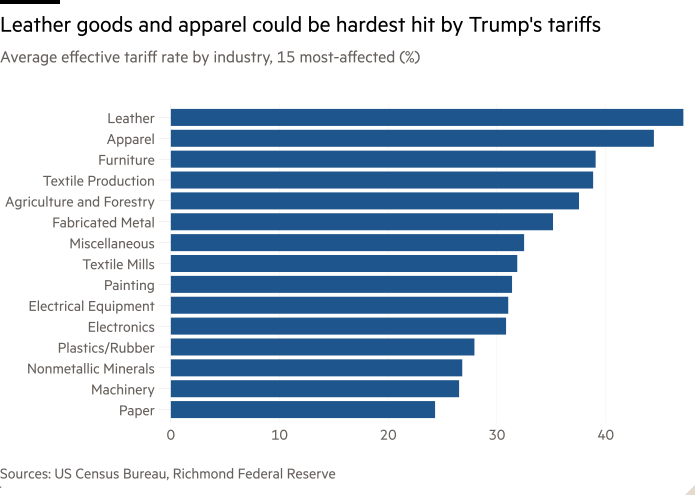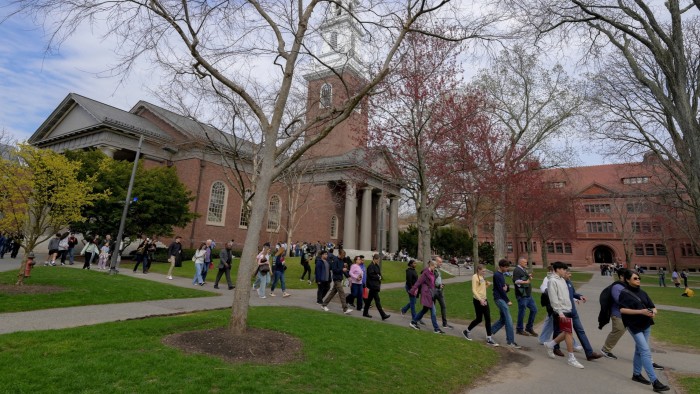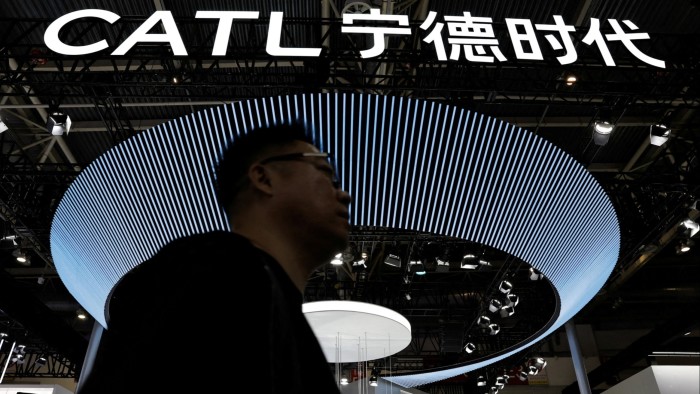US consumers face sharp price increases from Trump’s tariffs, say analysts

Unlock the White House Watch newsletter for free
Your guide to what the 2024 US election means for Washington and the world
Prices of leather goods, clothing, furniture and consumer electronics are expected to increase sharply for US households in the coming months because the country relies heavily on imports from nations targeted by Donald Trump’s sweeping tariffs, according to analysts.
Economists at the Richmond Federal Reserve forecast the US president’s so-called reciprocal tariffs, which are due to take effect on Wednesday, will have a “disproportionate impact” on various industries that import manufactured goods from Asia, including leather and apparel.
Goods imported to the US from China face tariffs of more than 104 per cent after the White House on Tuesday said Trump was pushing ahead with a further escalation of his trade conflict with Beijing.
Trump hit Vietnam, the second-largest apparel exporter to the US after China and a major supplier of leather goods such as handbags, with a 46 per cent tariff last week — one of the highest levies announced on his self-declared “liberation day”.
Cambodia, which supplies clothing brands including Lululemon and Hugo Boss, has been set a tariff of 49 per cent.
Smartphones, laptops, and video game consoles are likely to become more expensive for US consumers, particularly as many of Trump’s highest tariffs are focused on countries such as Vietnam and Taiwan, said Ed Brzytwa, vice-president of the Consumer Technology Association.
He added companies had shifted production to these countries amid rising trade tensions between the US and China during Trump’s first term as president.
Economists expect the tariffs will have sharp knock-on effect on consumer prices, even though some companies may in the long-term seek to blunt the financial impact by developing new supply chains.
The Yale Budget Lab, a policy think-tank, estimates US households will spend an average of $3,800 more each year from 2026 as a result of tariff-induced inflation, assuming no action from the Fed.
Trump’s tariffs have left the US central bank torn between whether to cut interest rates to prevent a sharp economic slowdown or keep them high to pre-empt a new burst of inflation.
In an interview with Illinois Public Radio on Tuesday, Austan Goolsbee, president of the Chicago Fed, said the levies announced last week were “way bigger” than policymakers had anticipated.
Tariffs may filter through to US consumer prices at an uneven pace. Brzytwa said electronics retailers and manufacturers had stockpiled three to four months of equipment in the US, which could ease price pressures before they need to begin importing again.
But other industries, particularly those that rely on perishable goods, may have a smaller window to act.
Imported foodstuffs, in particular, are likely to be among the first affected, in part because fresh produce does not last very long and is harder to stockpile.
The tariffs announced this year are expected to push up processed rice prices by 10.3 per cent in the coming months, according to the Yale Budget Lab.
The think-tank also forecast a 4 per cent increase in the price of vegetables, fruit and nuts, many of which are imported from Mexico and Canada.
Paul Donovan, chief economist at UBS, said he expected the impact of the latest levies would be passed on to consumers faster than during Trump’s previous tariff spree in 2018 — when it took several months — because most US retailers currently have less inventory to fall back on.
The belief that consumers are now “more accepting” of inflation following recent price shocks and widespread criticism of the Trump administration’s trade policy could also accelerate profit-led price increases by retailers, he added.
“With awareness of the tariffs increasing, US consumers are likely to blame any price increase, whatever the reason, on Trump’s trade taxes,” Donovan said.







